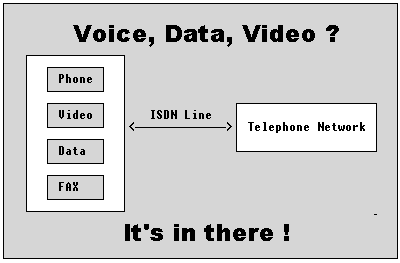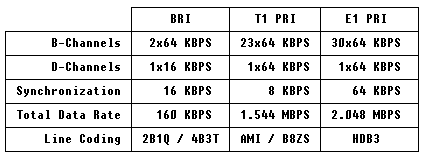| RETURN | ISDN Technology |
 Introduction to ISDN
Introduction to ISDN
What is ISDN?
ISDN is an abbreviation for Integrated Services Digital Network. It is the next-generation, digital telephone network that integrates circuit-switched voice and data services over a common access facility. There are two types of ISDN lines. Basic Rate ISDN (BRI) is designed for residential customers and small businesses. Primary Rate ISDN (PRI) is designed for larger businesses.


The Benefits of ISDN
- Reduces the cost of network administration
- Simplifies wiring
- Combines separate voice and data networking requirements
- Compatible with BRI/PRI, plus existing analog voice and Switched 56 services
For residential customers, Basic Rate ISDN (BRI) costs about the equivalent of two phone lines. BRI customers can gain high speed Internet access (64 KBPS to 128 KBPS). BRI improves the quality of speech in telephone calls. BRI provides an ideal way to keep in touch through personal videoconferencing. BRI offers improved modem connectivity to non-ISDN systems.
For business customers, ISDN offers cost savings through the integration of voice and data services. PRI provides a great backup solution for leased data lines. PRI offers high-quality video conferencing capabilities. PRI costs about the same as standard “channelized T1” services.
Basic Rate ISDN
Basic Rate ISDN (BRI) consists of three channels. Two channels are used for actual voice or data traffic with each one operating at a rate of 64 KBPS. These are called “Bearer” channels, or B-channels for short. There is a third channel that is used for call supervision (connecting, disconnecting, etc.). This channels operates at a rate of 16 KBPS and is called the “Delta” channel, or D-channel for short.
Using the S-bus interface of Basic Rate ISDN, it is possible to add multiple BRI devices (up to eight) to the same line.
Primary Rate ISDN
Primary Rate ISDN (PRI) operates at the Plesiochronous Level 1 digital rate. That is to say that it operates at T1 rates in North America and at the E1 rate for International systems.
In North American T1 PRI lines, 23 “Bearer” (B-channels) are available for voice or data traffic. Each B-channel operates at a 64 KBPS rate. There is an additional 64 KBPS channel that is used for call supervision, called the “Delta” channel (D-channel). The D-Channel is usually transported over DS0 #24.
In International E1 PRI lines, 30 “Bearer” (B-channels) are available for use. Again, each B-channel operates at 64 KBPS. A single D-Channel operates at 64 KBPS and is used for call supervision. The D-Channel is usually transported over DS0 #16.

